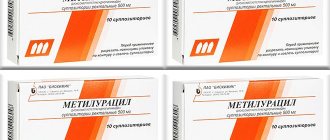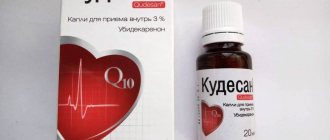0
Author of the article: Marina Dmitrievna
2018.10.13
31
Treatment-Drugs
Indomethacin is a modern non-steroidal anti-inflammatory drug that is often used to treat inflammatory joint diseases and eliminate unpleasant symptoms. The drug is very popular. It is available in different forms. You need to take it correctly. Before starting use, study the description of the drug "Indomethacin", instructions for use, features, contraindications and dosage regimen.
The medicine in the form of an ointment is the most popular
Compound
The main active ingredient is indomethacin. Auxiliary components depend on the form of the drug. Lactose, magnesium stearate, talc and silicon dioxide are used to create tablets. To create indomethacin suppositories, tallow and corn starch are used. Suppositories are applied rectally. Gel for external application is created from levomenthol, propylene glycol, purified water and macrogol.
The composition of each form of the drug is balanced and allows you to achieve maximum effect in the symptomatic treatment of diseases. All manufacturers use the same components.
Release form
In the pharmacy chain you can find the following options for Indomethacin:
- pills;
- rectal suppositories;
- ointment.
Tablets are available in 25 mg dosage. There are 30 pieces in one package. Suppositories are available in doses of 50 and 100 mg. Suppositories allow you to get the effect of using the medicine in a shorter time. From 6 to 10 candles are placed in a cardboard box. Ointment 10% is placed in an aluminum tube, which in turn is in a cardboard package.
If you want to purchase intramuscular injections, you will most likely need to make a choice in favor of another NSAID. Finding injections is extremely problematic. Indomethacin eye drops can be found in pharmacies under a different name.
Information about NSAIDs can be obtained from the video:
Important! The choice in favor of one or another form of release should be made after consultation with a specialist. The doctor will select the right option, prescribe the dosage and help you understand how to use the suppositories.
Contraindications
- Hypersensitivity to indomethacin or any of the excipients of the drug;
- anamnestic data on an attack of bronchial obstruction, rhinitis, urticaria after taking acetylsalicylic acid or other NSAIDs (complete or incomplete acetylsalicylic acid intolerance syndrome - rhinosinusitis, urticaria, nasal polyps, asthma);
- erosive and ulcerative changes in the mucous membrane of the stomach or duodenum, active gastrointestinal bleeding; inflammatory bowel diseases (ulcerative colitis, Crohn's disease);
- congenital heart defects (severe coarctation of the aorta, pulmonary atresia, severe tetralogy of Fallot);
- period after coronary artery bypass surgery;
- decompensated heart failure;
- renal failure (creatinine clearance (CC) less than 30 ml/min), progressive kidney disease;
- liver failure or active liver disease;
- bleeding disorders (including hemophilia, prolongation of bleeding time, bleeding tendency);
- hematopoietic disorders (leukopenia and anemia);
- confirmed hyperkalemia;
- hereditary lactose intolerance, lactase deficiency and glucose-galactose malabsorption,
- pregnancy and breastfeeding;
- children's age (up to 14 years).
Pharmacodynamics and pharmacokinetics
Indomethacin (chemical name indolylacetic acid) is a cyclooxygenase inhibitor. Thanks to its suppression, it is possible to eliminate pain and inflammation of a rheumatic and non-rheumatic nature. The medication allows you to achieve results in an extremely short time. It also helps eliminate fever. A pronounced anti-inflammatory effect develops approximately 1 week after use. The drug can be used either once (to eliminate unpleasant symptoms) or on an ongoing basis (the exact timing of treatment is determined by the doctor).
The drug helps fight pain in the knee joints
After consuming the drug in tablet form, the maximum concentration in the blood is reached after 2 hours. The substance is excreted in the urine. The half-life is approximately 4 hours. When using a suppository, the absorption rate increases slightly.
When applied topically, the drug is practically not absorbed into the systemic circulation. The cream helps fight inflammation and severe pain.
pharmachologic effect
Indomethacin has anti-inflammatory, analgesic, antipyretic and antiaggregation effects. Suppresses the activity of pro-inflammatory factors, reduces platelet aggregation. By inhibiting cyclooxygenase I and II, it disrupts the metabolism of arachidonic acid, reduces the amount of prostaglandins (Pg) both in the site of inflammation and in healthy tissues, and suppresses the exudative and proliferative phases of inflammation.
Eliminates or reduces pain of a rheumatic and non-rheumatic nature (including pain in the joints at rest and during movement, reducing morning stiffness and swelling of the joints, helps to increase range of motion; in inflammatory processes that occur after operations and injuries; quickly relieves both spontaneous pain and pain with movement; reduces inflammatory swelling at the wound site).
Indications and contraindications
The medication must be used strictly according to the instructions. Indications for use include:
- osteoarthritis;
- gout;
- arthrosis;
- chronic pain in the spine;
- traumatic inflammation of soft tissues (bruises, sprains).
In addition, Indomethacin can be used to relieve pain due to prostatitis in men, headaches, toothaches, fever and other manifestations of infectious and inflammatory diseases (cystitis, tonsillitis, rhinitis). For muscle and joint pain, a specialist can prescribe pills in courses. Early treatment of joint diseases is more effective.
Before use, you need to familiarize yourself with the contraindications and restrictions. Prohibitions on the use of medicine are:
- individual intolerance;
- ulcerative lesions of the stomach and intestines;
- hematopoietic disorder;
- 3rd trimester of pregnancy and a certain period of time after childbirth;
- breastfeeding period;
- hypertension;
- acute liver and kidney diseases;
- child's age under 14 years;
- anal fissure and proctitis (for suppositories).
The doctor should conduct an examination for possible contraindications. Only after this can you start using the product. The patient can purchase the medicine only with a prescription. If urgent use of NSAIDs is required, lactation can be suspended. When prescribing to a pregnant woman, the gynecologist must determine the need to use the drug. These issues are resolved in gynecology. It is worth remembering that use is only possible in the first two trimesters. As a rule, during this period the medicine is used to reduce the tone of the uterus.
Instructions for use
To minimize side effects, Indomethacin is used in minimal effective doses for the shortest possible period of time until clinical symptoms are completely eliminated. Tablets and suppositories are prescribed by a doctor after collecting anamnesis and eliminating possible restrictions. The dosage regimen is selected individually. External products are used strictly in accordance with official instructions. During treatment with systemic forms of Indomethacin for more than 10 days, kidney and liver function should be monitored, and constant laboratory monitoring of blood counts should be carried out. The rules of use and treatment regimen depend on the route of administration of the drug.
The instructions prescribe the following order of administration and dosage of Indomethacin:
- Tablets - take whole, after meals, with water. The initial dose is 2-3 tablets (50-75 mg) per day at regular intervals. It is permissible to increase it to 2 tablets at a time, 6 per day, but not more than 8 per day (200 mg). For long-term use, the maximum daily dose is 3 tablets (75 mg). In case of an acute attack of gout, the loading dosage is 100 mg, after reducing the intensity of pain - 2 tablets 3 times a day.
- Suppositories - insert into the rectum with a pointed end, ensuring deeper penetration of Indomethacin. It is advisable to use it before bedtime (a suppository with a dosage of 100 mg) and always after natural bowel movements, you can take 50 mg 2-3 times a day, without exceeding the maximum dosage - 200 mg.
- Ointment, gel - apply 2-4 times a day to a clean, dry surface in the area of maximum pain, distribute Indomethacin in a thin layer, using light rubbing movements. When applying, avoid wounds, infected areas, and mucous membranes. Do not cover the treated areas with hermetically sealed insulating bandages. Dosage for adults: single dose - 4-5 cm column of ointment (gel), daily - up to 15 cm. For adolescents 14-18 years old: single dose - 2-2.5 cm, per day - up to 7.5 cm. Maximum Duration of treatment – 2 weeks.
Attention!
In the absence of the expected result, it is prohibited to increase the recommended daily dosage above the maximum dose without the approval of a physician.
Violation of the instructions is fraught with overdose, its signs:
- gag reflex, up to the eruption of stomach contents;
- disorder of consciousness, disturbance of orientation, memory;
- Strong headache;
- changes in skin sensitivity;
- numbness of arms, legs, spasms.
In order not to expose the body to danger, Indomethacin should not be used in the following cases:
- individual intolerance to components, other NSAIDs;
- tendency to allergies, aspirin bronchial asthma;
- the presence of bleeding, exacerbations of gastrointestinal diseases, pancreatitis;
- disturbances in the activity of hematopoietic tissue;
- severe renal, hepatic, heart failure, arterial hypertension;
- inflammation of the rectum (for suppositories);
- ages 0-14 years;
- beginning of the 3rd trimester of pregnancy.
Under the supervision of a doctor: in old age, after operations, with renal, hepatic dysfunction, during pregnancy or breastfeeding.
Side effects
It is worth noting that improper use has a negative effect on the body. This may result in the following side effects:
- nausea;
- vomit;
- diarrhea;
- headache;
- convulsions;
- increased blood pressure;
- diarrhea;
- changes in blood parameters (decrease in the number of leukocytes).
Nausea when taking pills makes itself felt most often.
External use can cause redness, itching and other local effects. The occurrence of side effects may indicate improper use of the medicine. To eliminate them, the dose can be reduced.
Important! Using a contraindicated drug, a person significantly increases the risk of developing side effects.
Dosage and overdose
It is necessary to follow the dosage in order not to encounter negative manifestations. Tablets are used in a dose of 25 mg 2-3 times a day. They must be drunk an hour before meals. Suppositories are used in a dosage of 50 mg 1-3 times a day or in a dosage of 100 mg 1 time a day. Indomethacin ointment is applied to the affected area in a thin layer 1 to 3 times a day. The dosage of ampoules for injection is selected individually.
Take the tablets with plenty of water
To relieve toothache, just take 1 tablet. Reuse is possible after a few hours. The maximum daily dose is 200 mg. Medicine in the form of suppositories is better suited for use in infectious diseases.
If Indomethacin is used incorrectly, an overdose may occur. It is characterized by severe vomiting, dizziness and memory impairment. It is necessary to call an ambulance if you suspect an overdose. First aid and symptomatic treatment will be provided.
special instructions
The use of eye drops with indomethacin slows down corneal regeneration. When used simultaneously with lithium drugs, the therapeutic regimen is adjusted. Possible combined use with antibacterial agents in drops. In this case, the interval between administrations should be 15 minutes.
Read more Instructions for using Trusopt eye drops
When introduced into a therapeutic regimen with methotrexate (at a dose of less than 15 mg/week), it is necessary to donate blood weekly to monitor the formula. When prescribed to elderly patients, with kidney disease, heart and liver failure, medical supervision is necessary. After taking an antacid, before using eye drops from the NSAID group, you need to take a break of 2-2.5 hours.
If the patient wears contact lenses before using eye drops, they should be removed. Place it back only after the medication has been completely distributed over the front surface of the eye, no earlier than after 15 minutes.
Indocollier does not directly affect professional activities that require high concentration, such as driving a moving vehicle, or the performance of high-tech processes. But after use, the clarity of vision decreases. Therefore, you need to wait until it recovers, be sure to take a break.
Interaction
The ointment is well compatible with other classes of drugs. When used systemically, Indomethacin reduces the effectiveness of antihypertensive and diuretic drugs. Enhances the effect of anticoagulants, fibrinolytics and other anti-inflammatory drugs. When drawing up a treatment regimen, the doctor takes into account compatibility with other medications.
Combining the use of the medicine with alcoholic drinks is prohibited. Alcoholism and NSAID treatment lead to serious consequences. Combined use with alcohol can cause intoxication and bleeding. Alcoholic drinks should be avoided until the end of therapy.
The drug can be combined with antimicrobial agents. Antibiotics will help prevent bacterial infections. The specific antibacterial agent is selected by the doctor.
Analogs
A person can choose an analogue if he wants to replace Indomethacin with a cheaper option. The following funds are available:
| Name | Active substance | Price |
| Indomethacin-Biosynthesis | Indomethacin | 59 rubles for ointment 30 g |
| Indocollier | Indomethacin | 400 rubles for 5 ml drops |
| Methindol | Indomethacin | 160 rubles for 25 tablets 75 mg |
| Indomethacin number 100 Berlin-Chemie | Indomethacin | 352 rubles for 10 suppositories 100 mg |
A tablet substitute with a higher dose.
Your doctor will be able to help you choose a similar remedy.
Reviews
People respond positively to the medicine. They highlight the opportunity to purchase different forms of the drug and its high effectiveness.
I used Indomethacin tablets to combat toothache. Using this remedy, after 40 minutes I forgot about it. There were no negative aspects, so I recommend everyone to use this product.
Olesya, 28 years old
I completed a month's course of treatment with indomethacin. I was suffering from a knee injury. The doctor prescribed the drug at a dosage of 25 mg 3 times a day. There were no obvious side effects. Only problems arose with portability at the very beginning. It was necessary to slightly adjust the dose. A clear result was achieved. I feel much better now.
Alexey, 32 years old
Indications for use of ointment
Using the ointment helps get rid of joint pain, swelling, the consequences of bruises in the form of bruises, and inflammation inside the tissues.
Indomethacin ointment, the instructions for use of which suggest its use mainly as an anesthetic, also includes natural ingredients that nourish the joints, allowing them to quickly restore mobility and relieve pain.
Thanks to its main properties, Indomethacin ointment helps with:
- bruises;
- joint injuries;
- chronic joint diseases;
- morning swelling;
- stiffness in the joints.
For joint or back pain, use the ointment by simply rubbing it into the skin of the problem area. The composition is quickly absorbed.
Acute pain subsides within half an hour after application, the effect is consolidated within 8 hours.
To enhance the analgesic effect, it is proposed to apply applications by combining the ointment with essential oils or menthol. Usually they are kept for 10 - 15 minutes. Repeat 2-3 times during the day.
Occlusive dressings are not recommended.
Combined with heparin ointment, despite the fact that the anti-inflammatory effect increases, it is considered not relevant, since the anticoagulant nature of heparin is potentiated.
For people who suffer from joint diseases, waking up in the morning is a big problem, because after sleep the joints seem to become stiff, which hinders their mobility.
Important to remember! The process of so-called pacing, in order to bring swollen limbs and stiff joints into mobility, takes a lot of time and effort, since it is not painless.
| For what diseases is Indomethacin prescribed? | Indometacion ointment: what it helps with, symptoms |
| Rheumatoid arthritis | Stretching |
| Osteoarthritis | Inflammation |
| Exacerbation of gout, joint pain syndrome | Pain |
| Scoliosis | Edema |
| Schmorl's hernia | Tumors |
| Inflammation of tendons, ligaments, joints | Bruising |
| Radiculitis | |
| Formations (benign or malignant) in the joints and spine | |
| Osetoarthrosis of a deforming nature | |
| Tendinitis | |
| Muscle pain of various origins | |
| Injuries, bruises of soft tissues, as well as resulting problems with joints, muscles, ligaments and skin | |
| Superficial thrombophlebitis | |
| Neuralgia of various types | |
| Postoperative swelling (without breaking the skin: cuts, scratches, abrasions, open wounds) |
Indometacion ointment, instructions for use note this - it helps against inflammation of joints and tissues.
It is necessary to apply the ointment in a medium layer (not thin), rub it in a little, without excessive pressure, and then leave this area with the ointment on the surface for 15-20 minutes so that the remaining product is absorbed into the skin on its own. Only after this can the excess drug be removed with a cloth or cotton wool.
A single dose is counted in centimeters, along the length of the ointment squeezed out of the tube. For adults, the daily dose is 15 cm. This means that a single dose will be equal to 5 cm.
For children over 14, the recommended daily amount is 7.5 cm; 2.5 cm is enough for one rub. It is suggested to lubricate 3 times a day.
Attention! It should be applied only to the painful area of the body, in no case touching damaged skin; movements should be light and the application layer should be thin.
The course of treatment should not exceed 7-8 days. With longer use, it is necessary to monitor the blood test for platelets.
The drug is an effective remedy for joint pain in the following diseases:
- arthritis;
- rheumatism;
- gout;
- osteoarthritis;
- bursitis.
These diseases are characterized by common symptoms, which is why the use of Indomethacin ointment helps. In addition, under its influence, stiffness decreases and the range of movements expands, which is important for these debilitating diseases.
A wide range of successful use of the ointment extends to diseases of the spine:
- osteochondrosis;
- pinched roots;
- neuralgia;
- sciatica;
- lumbago.
Pathologies of the spine always cause acute, sharp, unexpected pain, which hinders movement, does not allow normal walking, sitting, lying, bending and even standing, which usually causes insomnia and irritability at every little thing.
Prescribing Indomethacin ointment helps relieve and alleviate such troubles.
Anyone who has experienced such ailments knows what it takes to relieve pain and resume normal function of the limbs and joints.
In addition to helping in the treatment of the musculoskeletal system, the drug helps with severe muscle pain, soft tissue bruises, sprains and other traumatic injuries.
Indomethacin ointment helps those who have undergone severe abdominal surgery to relieve pain in the postoperative period. It helps relieve inflammation, get rid of fever and pain.
Often used by athletes and people of other professions that are associated with possible bruises and sprains.
An ointment in which the concentration of the active substance is 5% is applied in the following dosage:
- Adults – 3 or 4 times a day, in a layer of about 3 cm;
- For a child - no more than 3 times a day, in a layer of 1.5-2 cm.
The duration of the course of using the ointment is prescribed only by a specialist, depending on the disease and its severity. However, the average course of ointment in complex treatment is no less than 7 and no more than 10 days.
If the expected effect does not occur during this time, the doctor should reconsider all prescribed treatment.
Indomethacin ointment containing a 10% concentrate of the active substance has the following treatment regimen:
- Adults – no more than 3 times a day;
- For a child - no more than 2 times a day.
Recommendations regarding the technique and layer of ointment application correspond to those when using ointment with 5% of the active substance.
Such indicators are approximate, but you should not overdo it with the use of ointment. Many people think that using ointments is safe in any quantity, but this is not true.
Even in cases with this form of medication, an overdose of certain active substances can form in the body, which has its consequences. Such consequences are especially dangerous for children.
| It is strictly forbidden to use ointment | Use ointment with caution |
| Individual intolerance to individual components of the drug (allergic reactions) | Haemorrhoids |
| Kidney or liver failure | Pancreatitis |
| Bronchial pathologies, in particular asthma | Children under 6 years of age |
| Additional treatment of intervertebral or hip joints | Lactation period |
| Liver diseases | Exacerbation of stomach or duodenal ulcers |
| Any heart disease | Existing blood clotting problems |
| Children under 1 year | |
| Pregnancy, lactation period | |
| Ulcerative lesions in the gastrointestinal tract | |
| Blood diseases (hemophilia) | |
| Bronchial pathologies, in particular asthma, nasal polyps |
Doctors pay special attention to the use of indomethacin-based ointment in childhood, because on the one hand, there are no strict restrictions in the instructions for use, only age up to 1 year, after a year it is possible.
At the same time, the use of this drug in children under 6 years of age should be under the constant supervision of parents over the general condition of the child.
Indeed, during this period, allergens that cause negative reactions in the child’s body may not yet have been identified.











